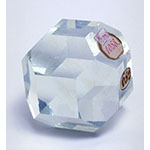Glass polyhedron with 18 faces (6 squares and 12 hexagons). Regular solids were used to demonstrate optical and geometrical principles. From Plato onward, they also inspired a new vision of the ultimate structure of matter. In the second century C.E., the early alchemists identified earth with the cube, fire with the tetrahedron, water with the icosahedron, air with the octahedron, and the Quintessence with the dodecahedron. With the rise of chemical and mineralogical crystallography in the late Renaissance, polyhedrons took on a new function and significance.
Context










